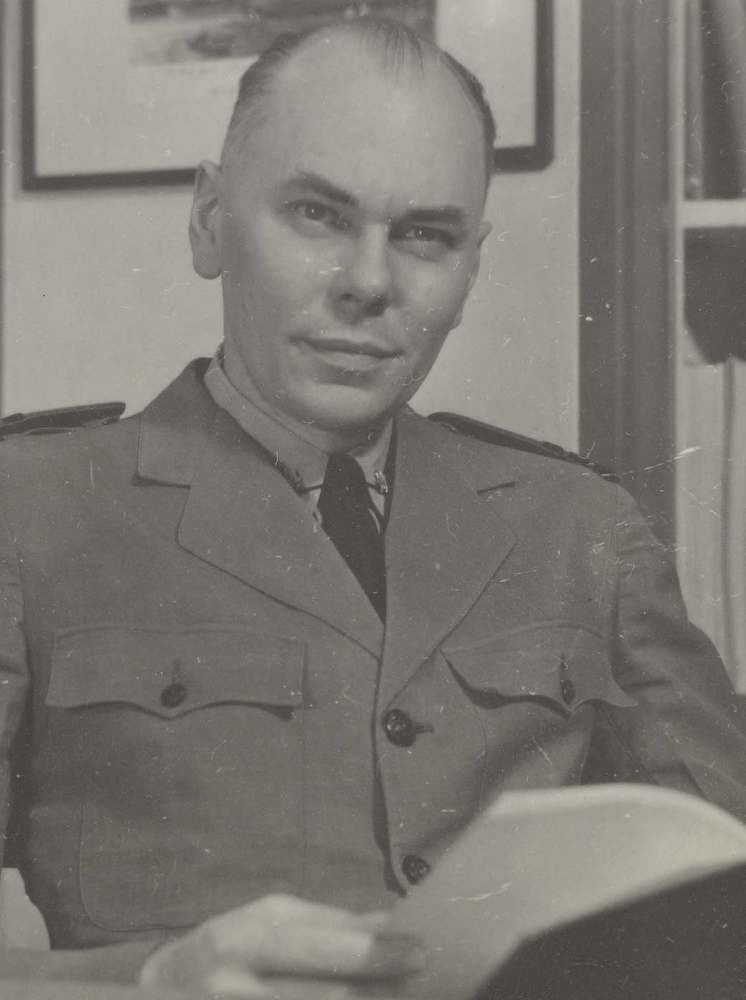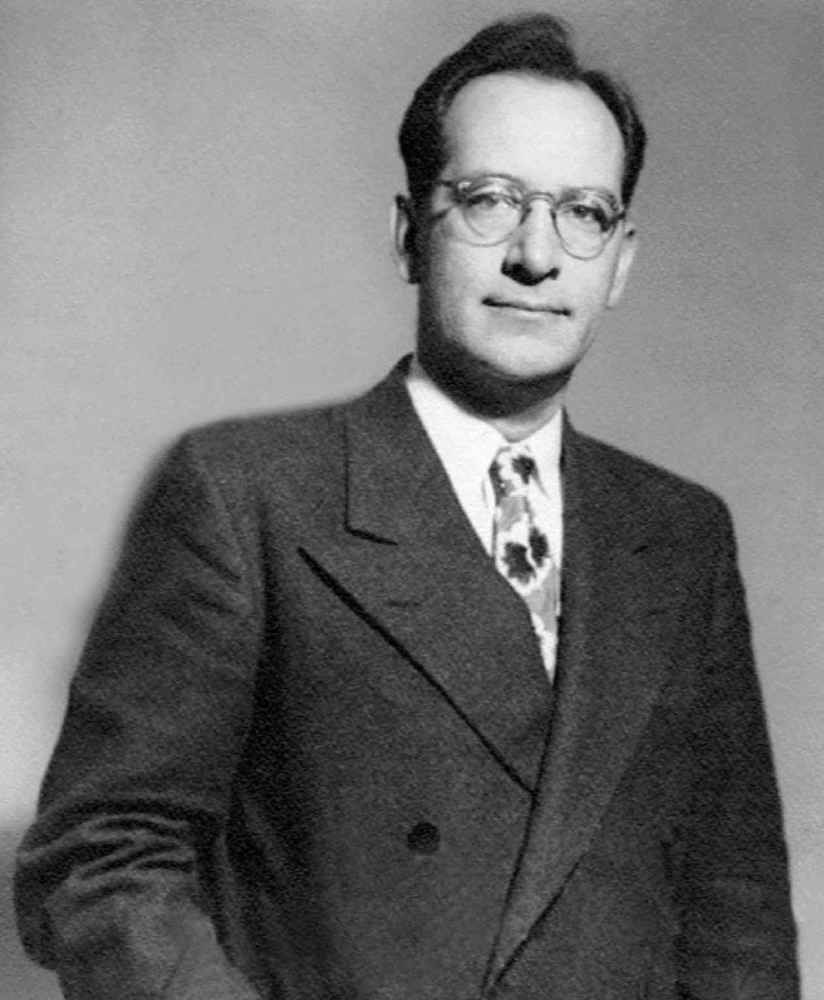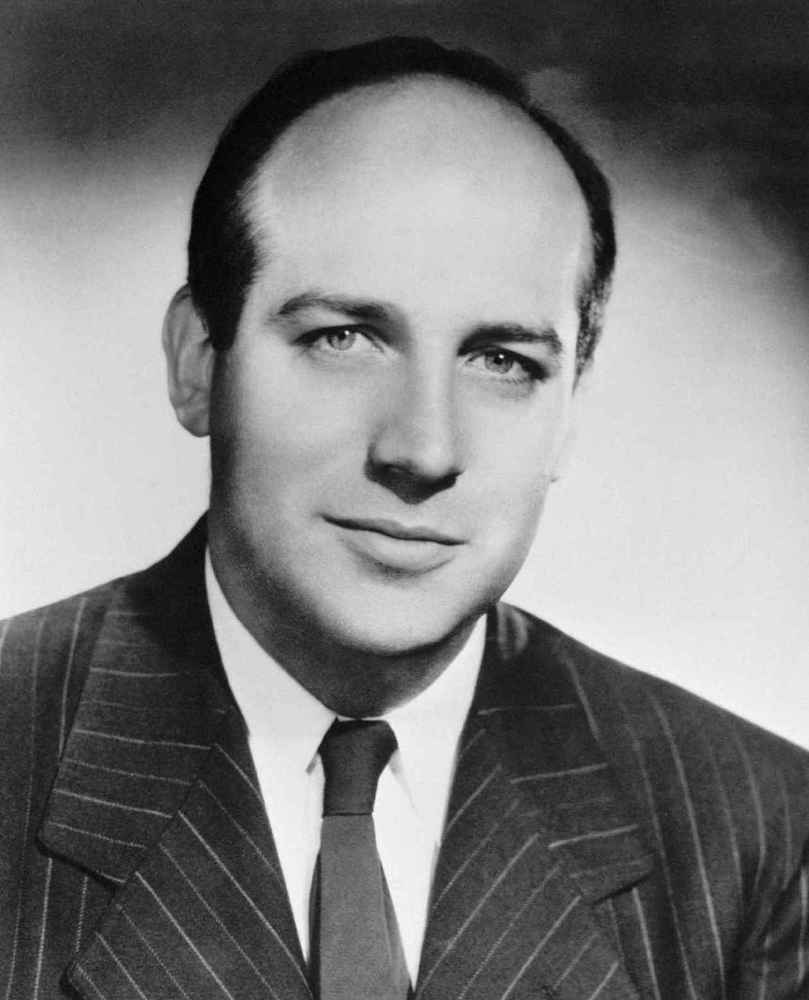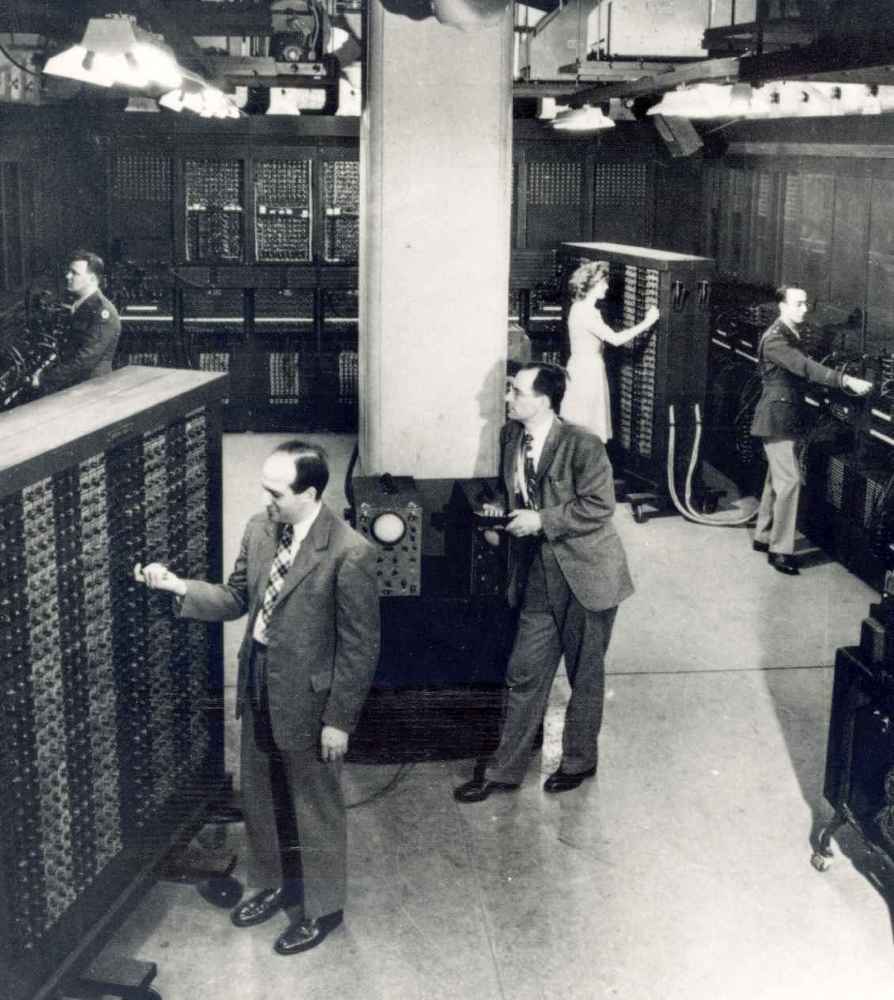Mauchly conveyed the good news in a letter to Atanasoff, which also contained hints of a plan that unnerved the Iowa professor. “A number of different ideas have come to me recently anent computing circuits—some of which are more or less hybrids, combining your methods with other things, and some of which are nothing like your machine,” Mauchly wrote, truthfully. “The question in my mind is this: is there any objection, from your point of view, to my building some sort of computer which incorporates some of the features of your machine?”59 It’s hard to tell from the letter, or from the subsequent explanations, depositions, and testimony over the ensuing years, whether Mauchly’s innocent tone was sincere or feigned.

Howard Aiken (1900–1973) at Harvard in 1945.

John Mauchly (1907–80) circa 1945.

J. Presper Eckert (1919–95) circa 1945.

Eckert (touching machine), Mauchly (by pillar), Jean Jennings (in back), and Herman Goldstine (by Jennings) with ENIAC in 1946.
Either way, the letter upset Atanasoff, who had still not succeeded in prodding his lawyer into filing any patent claims. He responded to Mauchly rather brusquely within a few days: “Our attorney has emphasized the need of being careful about the dissemination of information about our device until a patent application is filed. This should not require too long, and, of course, I have no qualms about having informed you about our device, but it does require that we refrain from making public any details for the time being.”60 Amazingly, this exchange still did not provoke Atanasoff or the lawyer to make a filing for patents.
Mauchly proceeded to forge ahead during that fall of 1941 with his own design for a computer, which he correctly believed drew ideas from a wide variety of sources and was very different from what Atanasoff had built. In his summer course, he met the right partner to join him in the endeavor: a graduate student with a perfectionist’s passion for precision engineering, who knew so much about electronics that he served as Mauchly’s lab instructor, even though he was twelve years younger (at twenty-two) and didn’t yet have his PhD.
J. PRESPER ECKERT
John Adam Presper Eckert Jr., known formally as J. Presper Eckert and informally as Pres, was the only child of a millionaire real estate developer in Philadelphia.61 One of his great-grandfathers, Thomas Mills, invented the machines that made salt water taffy in Atlantic City and, as important, created a business to manufacture and sell them. As a young boy, Eckert was driven by his family’s chauffeur to the William Penn private school, founded in 1689. But his success came not from the privileges of birth but from his own talents. He won a citywide science fair at age twelve by building a guidance system for model boats using magnets and rheostats, and at fourteen he devised an innovative way to use household current to eliminate troublesome batteries for the intercom system in one of his father’s buildings.62
In high school Eckert dazzled his classmates with his inventions, and he made money by building radios, amplifiers, and sound systems. Philadelphia, the city of Benjamin Franklin, was then a great electronics center, and Eckert spent time at the research lab of Philo Farnsworth, one of the inventors of television. Although he was accepted by MIT and wanted to go there, his parents did not wish him to leave. Pretending to have suffered financial setbacks because of the Depression, they pressured him to go to Penn and live at home. He did rebel, however, against their desire that he study business; instead he enrolled in the university’s Moore School of Electrical Engineering because he found the subject more interesting.
Eckert’s social triumph at Penn was creating what he called an “Osculometer” (from the Latin word for mouth), which purported to measure the passion and romantic electricity of a kiss. A couple would hold the handles of the device and then kiss, their lip contact completing an electric circuit. A row of bulbs would light up, the goal being to kiss passionately enough to light up all ten and set off a blast from a foghorn. Smart contestants knew that wet kisses and sweaty palms increased the circuit’s conductivity.63 Eckert also invented a device that used a light-modulating method to record sound on film, for which he successfully applied for a patent at age twenty-one, while still an undergraduate.64
Pres Eckert had his quirks. Filled with nervous energy, he would pace the room, bite his nails, leap around, and occasionally stand atop a desk when he was thinking. He wore a watch chain that wasn’t connected to a watch, and he would twirl it in his hands as if it were rosary beads. He had a quick temper that would flare and then dissolve into charm. His demand for perfection came from his father, who would walk around construction sites carrying a large pack of crayons with which to scrawl instructions, using different colors to indicate which worker was responsible. “He was sort of a perfectionist and made sure you did it right,” his son said. “But he had a lot of charm, really. He got things done most of the time by people wanting to do the stuff.” An engineer’s engineer, Eckert felt that people like himself were necessary complements to physicists such as Mauchly. “A physicist is one who’s concerned with the truth,” he later said. “An engineer is one who’s concerned with getting the job done.”65
ENIAC
War mobilizes science. Over the centuries, ever since the ancient Greeks built a catapult and Leonardo da Vinci served as the military engineer for Cesare Borgia, martial needs have propelled advances in technology, and this was especially true in the mid-twentieth century. Many of the paramount technological feats of that era—computers, atomic power, radar, and the Internet—were spawned by the military.
America’s entry into World War II in December 1941 provided the impetus to fund the machine that Mauchly and Eckert were devising. The University of Pennsylvania and the Army’s Ordnance Department at Aberdeen Proving Ground had been tasked with producing the booklets of firing-angle settings needed for the artillery being shipped to Europe. In order to be aimed properly, the guns required tables that factored in hundreds of conditions, including temperature, humidity, wind speeds, altitude, and gunpowder varieties.
Creating a table for just one category of shell shot by one gun might require calculating three thousand trajectories from a set of differential equations. The work was often done using one of the Differential Analyzers invented at MIT by Vannevar Bush. The machine’s calculations were combined with the labor of more than 170 people, most of them women, known as “computers,” who tackled equations by punching the keys and cranking the handles of desktop adding machines. Women math majors were recruited from around the nation. But even with all of this effort, it took more than a month to complete just one firing table. By the summer of 1942, it was clear that production was falling further behind every week, rendering some of America’s artillery ineffective.
That August, Mauchly wrote a memo that proposed a way to help the Army meet this challenge. It would change the course of computing. Titled “The Use of High Speed Vacuum Tube Devices for Calculating,” his memo requested funding for the machine that he and Eckert were hoping to build: a digital electronic computer, using circuits with vacuum tubes, that could solve differential equations and perform other mathematical tasks. “A great gain in the speed of calculation can be obtained if the devices which are used employ electronic means,” he argued. He went on to estimate that a missile trajectory could be calculated in “100 seconds.”66